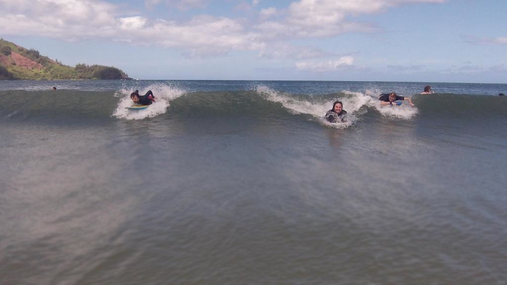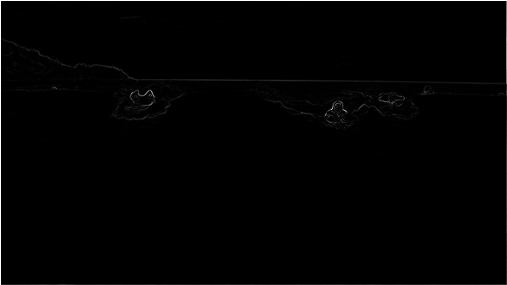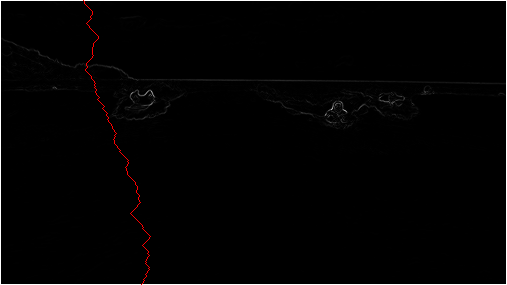

Warning: this assignment has not been battle-tested. It is likely that there are more ambiguities
and bugs. Please bring those to our attention and we will do our best to clarify and fix.
Seam-carving is a content-aware image resizing technique where the image is reduced in size by one
pixel of height (or width) at a time.
A vertical seam in an image is a path of pixels connected from the top to the bottom
with one pixel in each row.
(A horizontal seam is a path of pixels connected from the left to the right
with one pixel in each column.)
Below left is the original 505-by-287 pixel image; below right is the result after removing
150 vertical seams, resulting in a 30% narrower image.
Unlike standard content-agnostic resizing techniques (e.g. cropping and scaling), the most
interesting features (aspect ratio, set of objects present, etc.) of the image are preserved.
As you'll soon see, the underlying algorithm is quite simple and elegant. Despite this fact, this technique was not discovered until 2007 by Shai Avidan and Ariel Shamir. It is now a feature in Adobe Photoshop (thanks to a Princeton graduate student), as well as other popular computer graphics applications.


In this assignment, you will create a data type that resizes a W-by-H image using the seam-carving technique.
Finding and removing a seam involves three parts and a tiny bit of notation:
| (0, 0) | (1, 0) | (2, 0) |
| (0, 1) | (1, 1) | (2, 1) |
| (0, 2) | (1, 2) | (2, 2) |
| (0, 3) | (1, 3) | (2, 3) |
We also assume that the color of a pixel is represented in RGB space, using three integers between 0 and 255. This is consistent with the java.awt.Color data type.

The energy is high (white) for pixels in the image where there is a rapid color gradient (such as the boundary between the sea and sky and the boundary between the surfing Josh Hug on the left and the ocean behind him). The seam-carving technique avoids removing such high-energy pixels.

The SeamCarver API. Your task is to implement the following mutable data type:
public class SeamCarver {
public SeamCarver(Picture picture)
public Picture picture() // current picture
public int width() // width of current picture
public int height() // height of current picture
public double energy(int x, int y) // energy of pixel at column x and row y
public int[] findHorizontalSeam() // sequence of indices for horizontal seam
public int[] findVerticalSeam() // sequence of indices for vertical seam
public void removeHorizontalSeam(int[] seam) // remove horizontal seam from picture
public void removeVerticalSeam(int[] seam) // remove vertical seam from picture
public static void main(String[] args) // unit testing
}
As an example, consider the 3-by-4 image with RGB values (each component is an integer between 0 and 255) as shown in the table below.
| (255, 101, 51) | (255, 101, 153) | (255, 101, 255) |
| (255,153,51) | (255,153,153) | (255,153,255) |
| (255,203,51) | (255,204,153) | (255,205,255) |
| (255,255,51) | (255,255,153) | (255,255,255) |
The ten border pixels have energy 195075. Only the pixels (1, 1) and (1, 2) are nontrivial.
We calculate the energy of pixel (1, 2) in detail:
Rx(1, 2) = 255 − 255 = 0,
Gx(1, 2) = 205 − 203 = 2,
Bx(1, 2) = 255 − 51 = 204,
yielding Δx2(1, 2) = 22 + 2042 = 41620.
Ry(1, 2) = 255 − 255 = 0,
Gy(1, 2) = 255 − 153 = 102,
By(1, 2) = 153 − 153 = 0,
yielding Δy2(1, 2) = 1022 = 10404.
Thus, the energy of pixel (1, 2) is 41620 + 10404 = 52024.
Similarly, the energy of pixel (1, 1) is 2042 + 1032 = 52225.
We calculate the energy of the border pixel (1, 0) in detail:
Rx(1, 0) = 255 − 255 = 0,
Since there is no pixel (x, y - 1) we calculate
between pixel (x, y + 1) and pixel (x, height − 1).
Thus, the energy of pixel (1, 2) is 41616 + 10404 = 52020.
Gx(1, 0) = 101 − 101 = 0,
Bx(1, 0) = 255 − 51 = 204,
yielding Δx2(1, 0) = 2042 = 41616.
Ry(1, 0) = 255 − 255 = 0,
Gy(1, 0) = 255 − 153 = 102,
By(1, 0) = 153 − 153 = 0,
yielding Δy2(1, 2) = 1022 = 10404.
Remove this line: The table below has been modified:
| 20808.0 | 52020.0 | 20808.0 |
| 20808.0 | 52225.0 | 21220.0 |
| 20809.0 | 52024.0 | 20809.0 |
| 20808.0 | 52225.0 | 21220.0 |
| ( 97, 82,107) | (220,172,141) | (243, 71,205) | (129,173,222) | (225, 40,209) | ( 66,109,219) |
| (181, 78, 68) | ( 15, 28,216) | (245,150,150) | (177,100,167) | (205,205,177) | (147, 58, 99) |
| (196,224, 21) | (166,217,190) | (128,120,162) | (104, 59,110) | ( 49,148,137) | (192,101, 89) |
| ( 83,143,103) | (110, 79,247) | (106, 71,174) | ( 92,240,205) | (129, 56,146) | (121,111,147) |
| ( 82,157,137) | ( 92,110,129) | (183,107, 80) | ( 89, 24,217) | (207, 69, 32) | (156,112, 31) |
Remove: table has changed.
| 54572.0 | 51263.0 | 25436.0 | 17321.0 | 47599.0 | 36173.0 |
| 69374.0 | 23346.0 | 51304.0 | 31519.0 | 55112.0 | 61426.0 |
| 39387.0 | 47908.0 | 61346.0 | 35919.0 | 38887.0 | 46630.0 |
| 42086.0 | 31400.0 | 37927.0 | 14437.0 | 63076.0 | 16315.0 |
| 17637 | 47935.0 | 34879.0 | 10471.0 | 60270.0 | 42607.0 |
When there are multiple vertical seams with minimal total energy, your method can return any such seam.
Finding a horizontal seam. The behavior of findHorizontalSeam() as analogous to that of findVerticalSeam() except that it should return an array of W such that entry y is the row number of the pixel to be removed from column y of the image.
Performance requirements. The width(), height(), and energy() methods should take constant time in the worst case. All other methods should run in time at most proportional to W H in the worst case. For faster performance, do not construct an explicit EdgeWeightedDigraph object.
Exceptions. Your code should throw an exception when called with invalid arguments.
Picture class will throw this exception. Throw a java.lang.IllegalArgumentException if either removeVerticalSeam() or removeHorizontalSeam() is called when the width or height is 1.
Analysis of running time. Analyze your approach to this problem giving estimates of its time and space requirements by answering the relevant questions in the readme.txt file.
Extra Credit. Submit an image (either your own, or one in the public domain) for which the technique works particularly well (or poorly).
Include a brief description in the readme of what makes the image particularly (un)amenable to the technique.
Challenge for the bored.
The challenges worth extra credit are quite difficult, and you certainly shouldn't attempt them just for the points. Make sure to note if you've successfully completed them in your readme.
Submission. Submit SeamCarver.java, and any other files needed by your program (excluding those in stdlib.jar and algs4.jar). Finally, submit a readme.txt file and answer the questions.
This assignment was developed by Josh Hug, Maia Ginsburg, and Kevin Wayne.